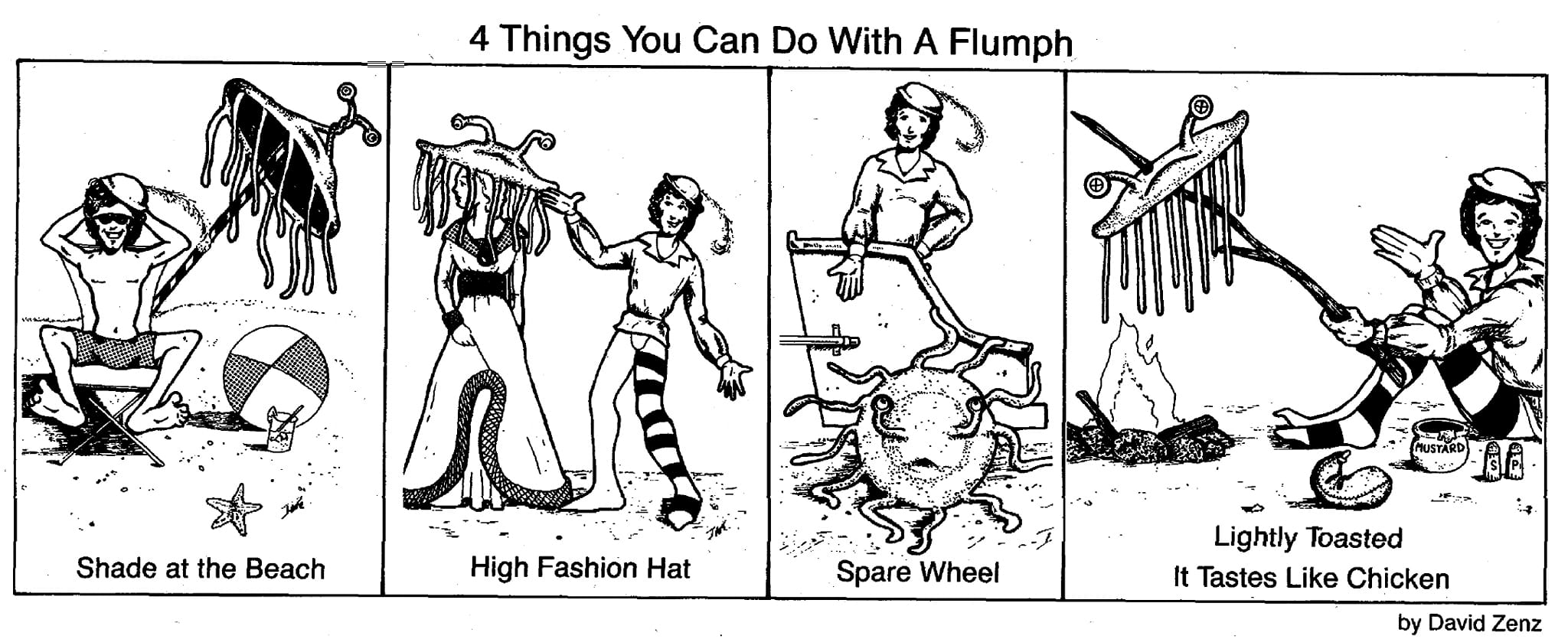^  ^
^

^  ^
^

![]()
FREQUENCY: Rare
FREQUENCY: Very rare ([Temperate
Wilderness Plains], [Temperate Wilderness Desert])
FREQUENCY: Very rare ([Tropical
Wilderness Plains], [Tropical Wilderness Desert])
FREQUENCY: Rare ([Dungeon Level II])
NO. APPEARING: 2-16
ARMOR CLASS: Upper surface
0; underside 8
MOVE: 6" (MC: D)
HIT DICE: 2
% IN LAIR: Nil
TREASURE TYPE: Nil
NO. OF ATTACKS: 1
DAMAGE/ATTACK: 1-8 plus 1-4
(acid)
SPECIAL ATTACKS: Nil
SPECIAL DEFENSES: Squirt
<>
INTELLIGENCE: Average (8-10)
ALIGNMENT: Lawful
good
SIZE: S (2' diameter) <(WEIGHT=?)>
LEVEL/X.P. VALUE: II | 36
+ 2
![]()
These strange creatures are
saucer shaped && pure white in colour.<4>
The mouth is at the centre
of the upper surface which is AC0;
either side of the mouth
is a 4" long eyestalk.
The underside is AC8 and
carries a mass of small spikes and numerous small tentacles.
The ![]() 'flies' by sucking air into its mouth and
expelling it through its underside.
'flies' by sucking air into its mouth and
expelling it through its underside.
Normally it floats about
4" above the ground but can fly up to 10', particularly for attack purposes.
Squirt:
Normally the ![]() repels an attack
with a squirt of foul-smelling liquid;
repels an attack
with a squirt of foul-smelling liquid;
this can strike anyone within
a 60° arc up to a
range of 20' --
any victim who fails his
save
(vs. poison) will FLEE in disgust.
The liquid is squirted through
an aperture on the creature's 'equator' --
the horizontal line of max.
diameter.
For 1-4 hours afterwards,
a victim struck by this liquid will be shunned by his companions who will
not be able to tolerate his presence within 100' until the effects wear
off.
<link: DSG odor
rules>
If this method of {repulsion}
fails the flumph will rise above itsTARGET and DROP
vertically on its chosen victim.
The spikes collectively inflict
1-8 HP of damage
and the tentacles fill the wounds with an acid
which does an additional 1-4 HP of damage,
the latter damage recurring
for the next 2-8 rounds unless magical means are used to negate the acid
(alchemists have so far failed to
create an effective antidote).
A ![]() is helpless if turned over.
is helpless if turned over.
The creature can communicate
in the lawful alignment tongue, <change
to : LG alignment tongue?>
though its vocabulary is
severely limited.
by Ian McDowall && Douglas Naismith
1. Life Cycle: A flumph reproduces
about every two years by budding,
producing 1d8 tiny flumphs on its underside.
These become independent after about three
months when they reach two inches in diameter.
They grow to adult size within a month,
and live for 20 years. - Flumph,
Monstrous Manual

Lunamancer wrote:
Col_Pladoh wrote:
Mislead the players, or stop
them from metagaming.
Would you believe this group actually used a hearts desire to bring a flunkh back to life because they wanted to "gamble" a bit more.

![]()
Indeed, and the odds with
that silly monster are better than those of
a Deck of Many Things...
something my players and
many other like groups seem to have loved messing around with ![]()
Cheers,
Gary
Quote:
Originally Posted by Aeolius
I suppose each player and
DM harbors their own beliefs as to what a "classic" critter might be. For
me, hags are the penultimate critter. Another suitable response might be
flumphs, which have been vastly overlooked in 3e, or the dragon
turtle, which has been denied "true" dragon status time and time again.
(edit: Gary, if you ever get
the deranged desire to play an ixitxachitl PC, just let me know) )

A flumph???
As for playing an ixitxachitl
PC, that would be Steve Marsh
Gary
<trim>
Quote:
Originally Posted by Aeolius
To be fair, in my campaigns
flumphs are known as uphlum and are related to both aboleth
and mind flayers.

Flumphs, heh-heh-heh.
Sorry, but I couldn't resist the urge.
Cheers,
Gary
<chat.j4>
<1: image
= x : not pure white>
<2: as
well, goblins are not green>
<3: as
well, that looks like a giant flumph, if those are supposed to be goblins>
<4:
white is not a colour!>
<
SIZE.WEIGHT:
AGE:
DIET:
EDIBLE: said to be foul-tasting
>